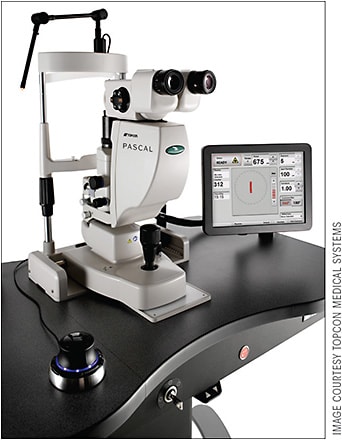Laser provides innovative pattern scanning laser trabeculoplasty.
In December 2017, Topcon Medical Systems received FDA approval for its Pattern Scanning Laser Trabeculoplasty (PSLT) for reducing intraocular pressure (IOP) in open-angle glaucoma. The laser is a tissue-sparing treatment, available as a software upgrade on the company’s Pascal Streamline laser. The automated technology is delivered in patterns to make treatments more precise and faster compared to other scanning laser trabeculoplasty, says Robert Gibson, vice president of Eye Care Global Marketing at Topcon.
“By providing a computer-guided treatment algorithm to use PSLT, the Pascal system makes trabeculoplasty — a sometimes challenging task — very manageable,” says Sandra Belalcazar-Rey, MD, head of the glaucoma department at the Fundación Oftalmológica Nacional in Bogotá, Colombia, who uses the laser at her practice. “The laser delivers a preset series of laser spots to the trabecular meshwork. The sequence and alignment of patterns on the trabecular meshwork ensures that consecutive treatment steps are performed without overlap or excessive gaps.”
As a result, PSLT causes less scarring and post-laser anterior chamber inflammation, and it reduces damage to endothelial cells, Dr. Belalcazar-Rey says. In addition, by using shorter pulse durations (from 10 ms to 5 ms) and predetermined patterns of spots, PSLT reduces thermal diffusion and associated unintended tissue damage.

User Friendly
As a physician already familiar with performing argon trabeculoplasty using other devices, Dr. Belalcazar-Rey was interested in trying PSLT to do this kind of procedure because of its added benefits. “The possibility of using less energy during trabeculoplasty and having less inflammatory reaction were good reasons to try it and see if patients would benefit from the technology,” she says.
Because his retina colleagues were enthusiastic about Pascal system’s use for retinal indications due to its significant time saving and positive patient feedback, Kaweh Mansouri, MD, MPH, consultant ophthalmologist at the Glaucoma Center of the Montchoisi Clinic in the Swiss Vision Network in Lausanne, Switzerland, was intrigued to apply it in glaucoma. “Because it is multifunctional, the Pascal Streamline laser system potentially reduces material acquisition costs and space concerns,” he says.
PSLT is easy to use because the algorithm simplifies and speeds up the procedure and provides accurate alignment of invisible treatment spots. The computer turns the pattern, letting the surgeon keep track of where spots have been applied, Dr. Belalcazar-Rey says. If a patient happens to move and the surgeon must stop and refocus, the laser indicates where to restart.
The Pascal Streamline laser system comes with an intuitive touchscreen, making it easy for physicians to select settings such as patterns, power, and spacing, Gibson adds.
In addition, Dr. Belalcazar-Rey says it doesn’t take much time to learn how to use PSLT. But the surgeon would have to know the anterior chamber’s anatomy and be able to visualize the trabecular meshwork. Proficiency in gonioscopy is also crucial.
Because the treatment outcome is subvisible, a computer-guided procedure provides automatic alignment of the patterns with no need for visible marks.1 Detailed summaries of each PSLT procedure are provided and can be printed, along with details of each laser setting, parameters, and locations of the patterns. “This automated documentation offers added security for record maintenance,” Gibson says.
Conditions PSLT Treats
The PSLT system is designed to treat patients who have open-angle glaucoma and an increase in IOP. In general, Dr. Mansouri says laser trabeculoplasty (with or without Pascal PSLT) is a good treatment option for newly diagnosed glaucoma patients in lieu of medicated eye drops or as an adjunct for patients whose high IOP is not adequately controlled with drops. It is also ideal for patients with ocular surface disease who are intolerant to drops and patients who aren’t compliant with using eye drops.
A study of 47 eyes of 25 patients with primary open angle glaucoma evaluated the effectiveness of PSLT using 532 nm wavelength light. After 1 month, average IOP was reduced from 21.9 mmHg to 16.0 mmHg. At 6 months, the average IOP was 15.5 mmHg. Overall, average IOP reduction of 24% in 6 months was achieved.1
Advantages for Patients
PSLT offers technology that is nondestructive, because energy is delivered below levels where conventional photocoagulation occurs. This produces cellular healing without scarring, burns, and coagulative damage associated with argon laser trabeculoplasty, Gibson says. However, treatment is still within the therapeutic range of trabecular meshwork response.
“Compared to traditional laser glaucoma treatments, such as SLT, PSLT offers comparable safety and efficacy with less patient discomfort,” Dr. Mansouri. He believes this may be the case because treatment is 50% faster compared to SLT; it only takes approximately two minutes. In fact, a study has shown that PSLT offers greater patient comfort over SLT.2 GP
References
- Turati M, Gil-Carrasco F, Morales A, et al. Patterned laser trabeculoplasty. Ophthalmic Surg Lasers Imaging. 2010;41(5):538-545.
- Mansouri K, Shaarawy T. Comparing pattern scanning laser trabeculoplasty to selective laser trabeculoplasty: a randomized controlled trial. Acta Ophthalmol. 2017;95(5):e361-e365.








